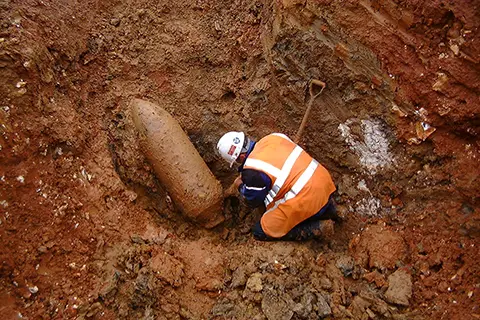Why is UXO still found in Rotherwas, Hereford?
Yesterday, a hand grenade was found in Rotherwas, Hereford. Why is unexploded ordnance (UXO) still found in Rotherwas, Hereford, over 70 years since WWII ended? Learn about Rotherwas' munitions factory, Luftwaffe bombings, and why UXO risk assessments are important for intrusive ground works.
Why is unexploded ordnance still found in Rotherwas, Hereford?
Following the discovery of a grenade in Rotherwas yesterday, (the very same day we, Hereford-based explosive threat mitigation company Igne was delighted to welcome HRH The Princess Royal (we love a coincidence)), it’s high time we explained why unexploded ordnance (UXO) is still found in Hereford.
Royal Ordnance Factory Rotherwas
Following the outbreak of WWI in 1914, Britain’s Ministry of Munitions sought land for the construction of multiple munitions production facilities.
On the 15th of June 1916, the Ministry acquired a 100-hectare site just south of Hereford at Rotherwas to create one of its munitions factories.
The Royal Ordnance Factory Rotherwas site included 43km of standard gauge railway, 4.8km of roads, 14km of guard fence, 16km of footpaths and 370 buildings. The buildings were spaced widely apart to avoid complete site destruction in the event of an accidental explosion. A fact that proved sagacious some years later.
A rail connected outpost was also established at Credenhill, used as a munitions store.
The facility in Hereford was responsible for the final production of munitions; work involved inserting explosives into shells produced elsewhere, and fitting detonators. Shell filling was started in November 1916, and part of the role was to produce mustard gas shells.
Hereford and the inter-war period
Rotherwas was the only one of 25 munitions sites retained between WWI and WWII. From 1926, it resumed filling gas shells and by the late 1930s, the Royal Navy used the site to fill sea mines.
Rotherwas during WWII
During WWII, the facility was once again used to produce shells and bombs for the RAF.
It was during WWII that events took place that can largely be blamed for the infrequent discovery of unexploded ordnance in Hereford to this day.
The site was subject to three major incidents - the first, on 12th September 1941, saw an explosion caused by faults in machinery which killed three people.
The second was a direct bombing…
Although Rotherwas is situated in the rural county of Herefordshire, which was subject to a low bombing density, 17 high explosive bombs were dropped across the county during WWII. And the Royal Ordnance Factory in Rotherwas was directly targeted.
On the 27th of July 1942 a Luftwaffe bomber dropped two 250kg high explosive bombs. There were many resultant fatalities and injuries.
Then, on the 30th of May 1944, a 2,000-pound bomb exploded whilst being filled, which set off a catastrophic and deadly chain reaction.
The smoking bomb in Hereford
A naval bomb was being filled when it began smoking. Workers and firefighters attempted to prevent a detonation by dousing the bomb with water, but they were unsuccessful. The bomb exploded and a significant area of the facility was damaged, with the filling house completely destroyed.
The chain reaction of explosions resulted in 31 bombs and mines detonating, damaging homes and businesses across the city and tragically, injuring and killing many people.
900 tons of live ordnance laid beneath the resultant rubble.
Post-WWII – why UXO is found in Hereford
Following efforts to clear the buried ordnance and then the end of WWII, the facility in Rotherwas was gradually reduced in size before closing in 1967.
Hereford council eventually bought the land and began its redevelopment. Today, Rotherwas is a thriving industrial estate, home to business from many sectors. It’s also an area that is constantly undergoing redevelopment and construction.
The intrusive ground works involved in the development of infrastructure and buildings can result in the accidental discovery of unexploded ordnance, particularly in areas affected by WWI/WWII (or on former military sites).
It’s why we, at Igne, support the construction sector by enabling them to meet their CIRIA C681 obligations and by encouraging them to at least commission a desktop threat assessment ahead of any ground works.
Why you need a UXO risk assessment ahead of intrusive ground works
Discovering unexploded ordnance may seem unlikely, but it is more common than you may expect. The article banner shows ordnance discovered on a construction site in London.
Finding UXO on your site can result in site evacuations, road closures, extensive delays, unforeseen costs, reputational damage, property damage, injuries or, in worst case scenarios, the loss of life.
By getting a UXO risk assessment from Igne, the risk of accidentally encountering UXO can be greatly reduced. Our reports are detailed, thoroughly researched, and include follow up actions if there is a high risk of UXO being present on your site.
Additionally, Igne can provide its UXO risk mitigation services to any site across the UK. With offices across Scotland, England and Wales, Igne is ready to deploy at a moment’s notice. We even provide turnkey site investigation solutions for the entire pre-construction phase!
To learn more about Igne’s UXO risk assessments and risk mitigation services, contact hello@igne.com / 01634 471340 today.
Other articles of interest

Ordnance found in Shrewsbury
Unexploded Ordnance (UXO) has been found in Shrewsbury three times in three weeks. Why is Shrewsbury facing this contamination issue, and what can be done about it?

What’s the value of UXO risk mitigation services?
What value do unexploded ordnance (UXO) risk mitigation services bring? What's the potential impact of UXO and who does it affect? Get all the answers to your frequently asked questions here.


